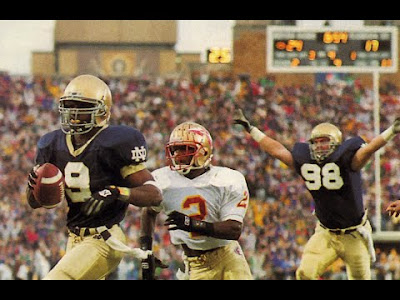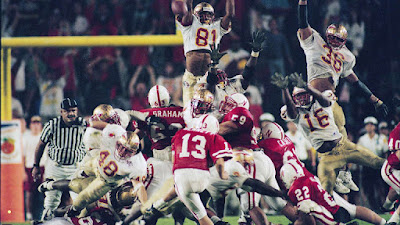1993 produced the biggest regular season game and best
single day of college football in my entire life.
What made the 1993 college football season feel so special
was the wide variety of teams involved in the national championship race and
the amazing stories that captivated the sports world that fall. For the first
time, it felt like college football had broken free from the “regional sport”
stereotype and became a true, national sport.
With the notable exception of the Pac-10, every major conference
had a national contender when November rolled around. The storylines, coaches,
and players involved made for a riveting, compelling fall. Prior to 1993, most
college football seasons at the very top revolved around a few teams that had a
chance to win it all. But in 1993, it felt like anything was possible.
The biggest regular season game, obviously, was Florida
State at Notre Dame in mid-November that was the Game of the Century in every
sense of the word. Florida State, coached by Bobby Bowden and led by eventual
Heisman Trophy winner Charlie Ward, felt like a team from the future. They had
athletes upon athletes all over the field, with a wide-open offense, which ran
over teams all year. On the flip side, Notre Dame was not a flashy Notre Dame,
but it ran through its season undefeated, and the game would be aired on NBC,
which had only recently started airing every Notre Dame home game.
The game was so big that ESPN’s then-fledgling pregame show,
College Gameday, decided to make its first-ever road trip. While today networks
send crews to every big game, this was completely different and unprecedented.
ESPN wasn’t even airing the game, why were there?
They were there because it was that big. Add in the
blue-gray November sky and the historic Notre Dame Stadium, and the game was
more Hollywood script than pigskin clash. The epic intro narrated by Bob Costas about how every kid grows up dreaming of playing in that type of game gives me
goosebumps to this day.
Notre Dame won that day 31-24. It is estimated that 40
million people watched that Saturday afternoon. Yes, 40 million. To give an indication of how big
that was in 1993 – Home Improvement was the #1 show on television that season
and the episode that aired three days before Notre Dame/Florida State drew 32.9 million viewers.
In the 29 years that have passed, there has only been one
other non-conference 1 vs 2 game in the regular season. It was an early
September game between Ohio State and a Texas team that would lose 3 games.
With the increase in conference sizes and the focus on the playoff, we’ll never
see a game like it again.
The most remarkable part of 1993 is how the biggest regular
season game in history was merely a prelude to the most insane finish to a
season, maybe ever.
That same day, #5 Ohio State, with only a tie on its record,
did what Ohio State became famous for in the 1990s – lose to an underdog
Michigan team. The loss sent Wisconsin to its first Rose Bowl in decades, which
the Badgers secured by beating Michigan State in Tokyo. Yes, Tokyo. Yes, I love
college football.
But Saturday, November 20, 1993 had more in store.
Undefeated West Virginia, in its biggest home game in school history, became
the first Big East team to take down Miami. The most memorable part of that
game came when the West Virginia crowd, in an age before smartphones, found out
that Notre Dame lost on the scoreboard, and they lost their minds.
Do you want more? We got more. Auburn beat Alabama 22-14 on
that same day, closing out an 11-0 regular season. It was a game no one watched
on television. Auburn was on probation and part of that probation meant none of its games would be televised. Yes, Auburn finished an undefeated season at home
by beating #11 Alabama and you had to be there in Jordan-Hare Stadium to watch
it. How is college football so awesome?
I’ve mentioned all of this, yet November 20, 1993, is
somehow not the best day of college football of my lifetime. In fact, it wasn’t
even the best of that year. Because New Year’s Day 1994 provided the most
outlandish, ridiculous lineup of games in postseason history, and each
delivered in spades.
The Fiesta Bowl selected Arizona to play Miami, which meant
the game had to be moved up to a 1pm start because a Pac-10 team was
contractually prevented from playing opposite the Rose Bowl. That game featured
Arizona obliterating Miami and essentially ending The U’s dynasty, which only
resurfaced briefly in the early 2000s.
The fun, though, was just getting started. The Rose Bowl
featured Wisconsin, making its first trip to Pasadena in 31 years, sneaking
past hometown UCLA 21-16.
At the same time, the first Cotton Bowl to ever be played in
the dark, moving into the Fiesta Bowl's vacated 4:30 p.m. slot on NBC, took place as 1-loss Notre Dame took on 1-loss Texas A&M. Notre
Dame felt aggrieved that it would possibly lose the national title to a Florida
State team it had beat in the regular season. Texas A&M was carrying the
weight of the Southwest Conference, which had not even scored a touchdown in
the Cotton Bowl in four years. Yes, the SWC champion – Texas in 1990 and Texas
A&M in 1991 and 1992 – had been held without a touchdown in the Cotton Bowl
for 180 minutes of football action. The game rocked, as Notre Dame pulled out a
thrilling 28-24 victory.
We weren’t close to done yet. Undefeated West Virginia was
sent to the Sugar Bowl, to play Steve Spurrier’s Florida. The Mountaineers,
like Notre Dame, were an aggrieved party feeling that its undefeated season
deserved to end in a title shot. They didn’t get it, and they probably didn’t
deserve it. Florida wiped the Superdome turf with West Virginia, winning a 41-7
laugher.
It's hard to overstate how insane that New Year’s Day was,
starting at 11am in the morning on ESPN and ending sometime past midnight in
Miami. I was 11 years old, and I truly felt like sports on television would
never be better.
Sadly, I was right. New Year’s Day 1994 was the last time
that the big Four bowl games – Cotton, Sugar, Rose, and Orange – were played on
the same day.
For the 1994 season, NBC played the Orange Bowl on New
Year’s Night, but it was a twist. That was a Sunday, and for years all college
games moved to Monday when that happened. However, NBC had the NFL playoffs
during the day and nothing at night, so it moved the Orange Bowl to its own
slot vs no competition. Tom Osborne finally got his national title, and the
next day’s glut of games on New Year’s Day felt meaningless.
Playing a national championship decider before New Year’s
Day? How stupid is that? I’m sure college football wouldn’t make that mistake again.
By 1995, the new Bowl Alliance made its first appearance,
moving a supposed title game to January 2, but it only worked once. The Big
Ten/Pac-10 agreement for the Rose Bowl meant two split national titles between
1993 and the advent of the BCS, along with the 1996 season where #1 and #2
played in different bowl games and both lost.
1993 was the absolute peak of the college football bowl
system. Everything worked to perfection, starting with that glorious Saturday
afternoon in South Bend.
In retrospect, it may have worked too well. Because TV execs
and school leaders saw the amount of money that could be made – and the amount
of money that was being left on the table.
The 1993 season ended with college football’s last true New
Year’s Day.
It would be another a decade-plus until the stars aligned
for college football to produce another perfect, peak season.



Comments
Post a Comment